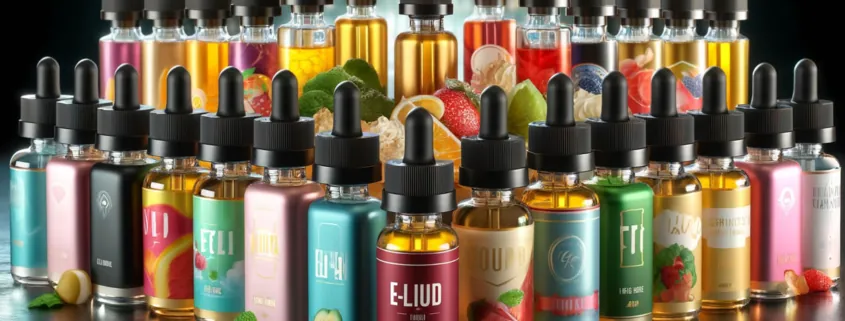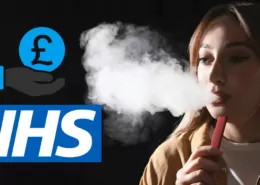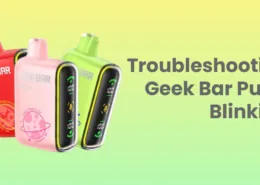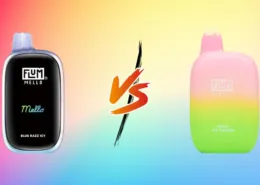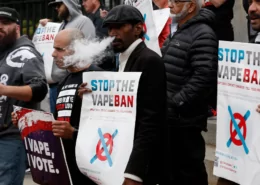A Comprehensive Guide to Choosing Your Perfect Vape Juice
Your ultimate guide to e-cigarette liquids: understanding PG/VG ratios, nicotine strengths (freebase/salts), flavors, and choosing the best vape juice.
In the diverse and evolving world of vaping, e-liquids are the very essence of the experience. They are the alchemists’ concoctions that transform a simple device into a source of flavour, sensation, and for many, an alternative to traditional smoking. The choice of e-liquid, often referred to as vape juice, e-juice, or vaping liquid, extends far beyond mere taste preference. It encompasses considerations of safety, user satisfaction, the desired vaping experience (from throat hit to cloud production), and crucial compatibility with your specific vaping device. Understanding the fundamentals of e-liquid composition, the various types available, and how to select the most suitable option is key to a fulfilling and safe vaping journey.
The Anatomy of an E-Liquid: What’s Inside Your Vape?
At its core, an e-liquid is a specially formulated solution designed to be heated by the coil (atomizer) within an e-cigarette, transforming it into an inhalable aerosol or vapor. While recipes can vary, the foundational ingredients are relatively consistent across the industry:
- Propylene Glycol (PG): This is a common food-grade additive, recognized as safe by health authorities like the U.S. Food and Drug Administration (FDA) for use in a variety of consumer products. In e-liquids, PG is a thin, colorless, and odorless liquid. Its primary roles are to act as an effective carrier for flavour concentrates and nicotine, and to provide the “throat hit” – a sensation at the back of the throat that many former smokers find satisfying as it mimics the feeling of inhaling tobacco smoke. E-liquids with a higher PG ratio tend to produce less dense vapor but offer sharper, more defined flavors.
- Vegetable Glycerin (VG): Another common food-grade substance, VG is derived from vegetable oils. It is considerably thicker and more viscous than PG and has a slightly sweet taste. In vaping, VG is prized for its ability to produce large, dense clouds of vapor. E-liquids with a higher VG concentration generally provide a smoother inhale with less throat hit and are often preferred by “cloud chasers” or those using more powerful, sub-ohm devices. However, due to its thickness, high VG liquids may not wick efficiently in all types of coils, particularly smaller, simpler ones.
- Flavourings: This is where the vast diversity of the e-liquid market truly shines. Flavour concentrates can be derived from natural sources or created synthetically (food-grade). The range is virtually limitless, spanning traditional tobacco and menthol profiles to an extensive array of fruits (from single fruits like strawberry or mango to complex fruit medleys), desserts and creams (vanilla custard, cheesecake, chocolate), beverages (coffee, cola, cocktails), and even more unique or “gourmet” concoctions. The quality and complexity of flavourings are significant differentiators between e-liquid brands.
- Nicotine (Optional): For many vapers, particularly those using e-cigarettes as an alternative to smoking, nicotine is a key ingredient. It can be present in various concentrations, typically measured in milligrams per milliliter (mg/ml), or as a percentage. Common strengths range from 0mg/ml (nicotine-free) up to 18mg/ml or 20mg/ml (the legal limit in regions like the UK and EU).
- Freebase Nicotine: This is the traditional form of nicotine used in most e-liquids and was the standard in early vaping products. It provides a noticeable throat hit, especially at higher concentrations.
- Nicotine Salts (Nic Salts): A more recent innovation, nicotine salts are formulated to allow for the inhalation of higher nicotine concentrations with a much smoother throat hit compared to freebase nicotine at equivalent strengths. This can make them more palatable for new vapers or those seeking a faster nicotine delivery, more akin to that of a cigarette. Nic salts are often preferred in lower-power, pod-based devices.
- Read more: What’s the Differences Between Salt Nicotine vs Freebase Nicotine
This carefully balanced mixture, contained within a vape tank, pod, or cartridge, is heated by the device’s coil, turning it into the vapor that is then inhaled. This process avoids combustion, which is the primary source of harmful toxicants in traditional cigarette smoke, making vaping widely considered by public health bodies like Public Health England to be significantly less harmful than smoking.
Navigating the E-Liquid Market: Main Types Available
The e-liquid market caters to a wide spectrum of user preferences and technical know-how. Understanding the different types of e-liquids available helps users avoid purchasing errors and allows for a more personalized and satisfying vaping experience.
1. Ready-to-Use E-Liquids (10ml Bottles)
Often referred to as “10mls” or standard e-liquids, these are pre-mixed solutions containing the base (PG/VG), flavourings, and a specified nicotine strength (or 0mg for nicotine-free options). They are sold in small bottles, typically 10ml, due to regulations in many regions (like the UK/EU’s TPD/TRPR) that limit the size of nicotine-containing e-liquid bottles.
2. Concentrated Flavourings (for DIY Mixing)
For the more experienced or adventurous vaper, concentrated flavourings offer the ultimate in customization. These are pure, undiluted flavour essences that must not be vaped directly as they are far too potent. They are designed to be mixed by the user with a neutral base liquid (a separate purchase of PG and VG, often pre-mixed in desired ratios like 70VG/30PG or 50VG/50PG) and, if desired, nicotine shots (10ml bottles of high-strength, unflavoured nicotine in a PG or VG base).
3. Shortfills / Mix & Vape Liquids
Shortfills (also known as “Shake & Vape” or “Mix & Vape”) offer a popular middle ground between the convenience of ready-to-use liquids and the customization of full DIY mixing. These are larger bottles (e.g., 60ml, 120ml) containing nicotine-free e-liquid that is highly concentrated in flavour, with some empty space left at the top of the bottle. This space is designed for the user to add one or more 10ml nicotine “shots” (or nicotine-free base if they prefer 0mg) to achieve their desired overall nicotine strength and volume.
For example, a 50ml shortfill in a 60ml bottle allows for one 10ml nicotine shot to be added, typically resulting in 60ml of 3mg/ml e-liquid if an 18mg/ml nicotine shot is used.
Choosing the Right E-Liquid: Key Factors to Consider
Selecting the most suitable e-liquid involves balancing several personal preferences and technical considerations.
Flavour Profile and Intensity
This is often the most subjective yet crucial factor. The “best” flavour is entirely down to individual taste. Common categories include:
- Tobacco Flavours: Designed to replicate the taste of various traditional cigarette or cigar tobaccos. Ideal for those transitioning from smoking or who prefer a familiar, robust taste.
- Fruity Flavours: A vast category ranging from single fruit notes (strawberry, blueberry, mango) to complex blends (mixed berries, tropical punch). Often fresh, light, and suitable for all-day vaping.
- Dessert/Creamy/Sweet Flavours: Indulgent profiles like vanilla custard, cheesecake, chocolate, cookies, or caramel. Perfect for those with a sweet tooth or who enjoy rich, enveloping vapes.
- Menthol or Ice Flavours: Provide a cool, refreshing sensation. Can be standalone or combined with fruit or tobacco flavours for an added icy kick.
- Beverage Flavours: Mimic popular drinks like coffee, cola, energy drinks, or cocktails.
The perceived intensity of a flavour can also be influenced by the PG/VG ratio. Higher PG liquids tend to carry flavour more distinctly, while high VG liquids, known for cloud production, can sometimes slightly dampen or “mute” the flavour intensity for some users.
Nicotine Strength and Type
Choosing the correct nicotine strength is vital for satisfaction, especially for those using vaping to quit smoking. Too low, and cravings may not be satisfied; too high, and it can cause harshness or discomfort (dizziness, nausea).
A general guideline based on previous smoking habits:
- 0mg/ml: For individuals who have successfully quit nicotine or who vape purely for flavour and the act itself.
- 3-6mg/ml (Freebase): Suitable for light smokers (e.g., up to 10 cigarettes per day) or those using higher-power, direct-to-lung (DTL) devices where more vapor is inhaled per puff.
- 9-12mg/ml (Freebase): Often recommended for moderate smokers (e.g., 10-20 cigarettes per day) using mouth-to-lung (MTL) devices.
- 18mg/ml and above (Freebase, up to legal limits): Typically for heavier smokers (20+ cigarettes per day) or those using very low-wattage, discreet MTL systems.
- Nicotine Salts (e.g., 10mg/ml, 20mg/ml): Excellent for new vapers transitioning from smoking or those who prefer a smoother throat hit despite higher nicotine levels. Nic salts are absorbed more quickly by the body, providing a faster nicotine satisfaction. They are ideal for pod systems and low-power MTL devices.
It’s often a process of trial and error to find the perfect nicotine strength. Starting lower and adjusting upwards if needed, or vice versa, is a common approach.
Compatibility with Your Vaping Device
The type of vaping device you use significantly influences the ideal e-liquid choice, particularly the PG/VG ratio:
- High VG Liquids (e.g., 70VG/30PG or 80VG/20PG): These thicker liquids are best suited for powerful, sub-ohm devices designed for direct-to-lung (DTL) vaping. These devices have larger coil wicking ports that can handle the viscosity, and their higher power output is ideal for producing large vapor clouds. Using high VG liquid in a small, low-power pod system can lead to poor wicking, dry hits, and burnt coils.
- 50VG/50PG Liquids: A balanced ratio suitable for a wide range of devices, including many starter kits, pod systems, and MTL tanks. Offers a good balance of flavour, throat hit, and vapor production.
- High PG Liquids (e.g., 40VG/60PG or 30VG/70PG): These thinner liquids are ideal for lower-power devices, basic starter kits, and MTL tanks with smaller coil wicking holes. They provide a stronger throat hit and better flavour definition. Using high PG liquid in a high-power sub-ohm device can result in an overly harsh throat hit and potential leaking.
Important Note: Using an e-liquid with an inappropriate PG/VG ratio for your device can compromise flavour, lead to leaking, cause coils to burn out prematurely, or result in an unpleasant vaping experience.
Safe Storage and Use of E-Liquids: Best Practices
Once you’ve selected your e-liquids, proper storage and handling are crucial to maintain their quality, safety, and longevity:
- Avoid Direct Sunlight: UV rays can degrade nicotine and alter the chemical composition of flavourings, negatively impacting taste and potency. Store bottles in a dark place.
- Keep Away From Heat Sources: High temperatures accelerate the degradation process. Avoid leaving e-liquids in hot cars or near radiators.
- Store in a Cool, Dry Place: A closed drawer, cupboard, or dedicated storage box is ideal. Consistency in temperature is beneficial.
- Ensure Caps are Tightly Closed: After each use, securely tighten the cap to prevent oxidation (exposure to air), which can degrade nicotine and flavours over time.
- Keep Out of Reach of Children and Pets: E-liquids, especially those containing nicotine, can be harmful if ingested. Always store them securely away from children and animals. Child-resistant caps are a regulatory requirement for nicotine-containing liquids but should not be solely relied upon.
- Check Expiry Dates: While e-liquids generally have a long shelf life (often 1-2 years if stored properly), it’s good practice to check for any expiry or best-before dates provided by the manufacturer.
- Use Certified and Reputable Products: Always purchase e-liquids from reputable vendors and brands that adhere to quality control standards and regulatory requirements (like TRPR in the UK/EU). Avoid products of dubious origin or those sold without proper labelling or safety information.
- Follow Manufacturer’s Instructions: Always adhere to any specific storage or usage instructions provided by the e-liquid manufacturer and your device manufacturer.
Conclusion: Finding Your Vaping Sweet Spot
Choosing the right e-liquid is a journey of discovery, blending personal taste with an understanding of how different components interact with your vaping device and your own preferences for nicotine delivery and sensation. Whether you opt for the simplicity of ready-to-use liquids, the customization of DIY mixing, or the balanced approach of shortfills, the key is to select high-quality, compliant products that suit your needs.
By considering flavour profiles, nicotine strength and type, PG/VG ratios appropriate for your hardware, and adhering to safe storage practices, you can significantly enhance your vaping experience, ensuring it is both enjoyable and responsible. Don’t be afraid to experiment (safely and within regulatory guidelines) and consult with knowledgeable staff at reputable vape shops who can offer guidance tailored to your specific setup and preferences.
- Spain Warns Tourists of €2,000 Fines for Vaping on Beaches - August 12, 2025
- The Ultimate Guide to Glass Bongs: Elevate Your Smoking Experience - August 12, 2025
- Tourists Face Fines for Nicotine Pouches in France & More - August 12, 2025

